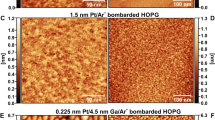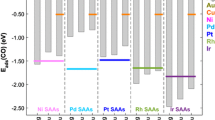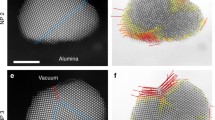Abstract
Single atom alloy (SAA) catalysts, consisting of oxide supported dilute alloy nanoparticles (NPs), have become increasingly popular due to their unique chemical reactivity and ability to selectively facilitate catalytic reactions. While SAA catalysts are typically synthesized with a uniform alloy composition, it is well known that the surface composition can vary from that in the bulk due to environmental conditions. Herein we demonstrate how environmental conditions can impact the structure of Pt in supported silver-platinum (AgPt) dilute alloy NPs. We employ ab initio thermodynamic models parameterized by density functional theory calculations to explore favorable structures under inert conditions and in the presence of adsorbates such as carbon monoxide (CO). These calculations show that in the absence of strongly interacting adsorbates, Pt is favored to reside in the Ag bulk, while under CO rich environments, Pt is stabilized at the surface in a variety of configurations. We experimentally verify these calculations by colloidally synthesizing AgPt NPs supported on alumina and characterizing Pt structures using electron microscopy paired with in situ infrared spectroscopy and X-ray absorption spectroscopy. Detailed characterization shows evidence that isolated Pt sites can be stabilized at the surface in the presence of CO and, depending on environmental conditions, that some fraction of surface Pt atoms are coordinated to sub-surface Pt. Density of states calculations show that structures where surface Pt is coordinated to subsurface Pt have markedly different electronic structures and therefore suggests such changes in Pt coordination environment can influence catalytic processes.
Graphical Abstract

Similar content being viewed by others
References
Ball MR, Rivera-Dones KR, Gilcher EB et al (2020) AgPd and CuPd catalysts for selective hydrogenation of acetylene. ACS Catal. https://doi.org/10.1021/acscatal.0c01536
Carter JL, McVinker GB, Weissman W et al (1982) Bimetallic catalysts; application in catalytic reforming. Appl Catal 3:327–346. https://doi.org/10.1016/0166-9834(82)80267-4
Sinfelt JH (1977) Catalysis by alloys and bimetallic clusters. Acc Chem Res 10:15–20. https://doi.org/10.1021/ar50109a003
Sinfelt JH (1999) Catalysis: an old but continuing theme in chemistry. Proc Am Philos Soc 143:388–399
Yu W, Porosoff MD, Chen JG (2012) Review of Pt-based bimetallic catalysis: from model surfaces to supported catalysts. Chem Rev 112:5780–5817. https://doi.org/10.1021/cr300096b
Hammer B, Nørskov JK (1995) Electronic factors determining the reactivity of metal surfaces. Surf Sci 343:211–220
Baz A, Holewinski A (2020) Understanding the interplay of bifunctional and electronic effects: microkinetic modeling of the CO electro-oxidation reaction. J Catal 384:1–13. https://doi.org/10.1016/j.jcat.2020.02.003
Jacobsen CJH, Dahl S, Clausen BGS et al (2001) Catalyst design by interpolation in the periodic table: bimetallic ammonia synthesis catalysts. J Am Chem Soc 123:8404–8405. https://doi.org/10.1021/ja010963d
Hannagan RT, Giannakakis G, Flytzani-Stephanopoulos M, Sykes ECH (2020) Single-atom alloy catalysis. Chem Res. https://doi.org/10.1021/acs.chemrev.0c00078
Giannakakis G, Flytzani-Stephanopoulos M, Sykes ECH (2018) Single-atom alloys as a reductionist approach to the rational design of heterogeneous catalysts. Acc Chem Res. https://doi.org/10.1021/acs.accounts.8b00490
Liu J, Lucci FR, Yang M et al (2016) Tackling CO poisoning with single-atom alloy catalysts. J Am Chem Soc 138:6396–6399. https://doi.org/10.1021/jacs.6b03339
Darby MT, Sykes ECH, Michalides A, Stamatakis M (2018) Carbon monoxide poisoning resistance and structural stability of single atom alloys. Top Catal 61:428–438. https://doi.org/10.1007/s11244-017-0882-1
Darby MT, Stamatakis M, Michaelides A, Sykes ECH (2018) Lonely atoms with special gifts: breaking linear scaling relationships in heterogeneous catalysis with single-atom alloys. J Phys Chem Lett 9:5636–5646. https://doi.org/10.1021/acs.jpclett.8b01888
Liu J, Uhlman MB, Montemore MM et al (2019) Integrated catalysis-surface science-theory approach to understand selectivity in the hydrogenation of 1-hexyne to 1-hexene on PdAu single-atom alloy catalysts. ACS Catal 9:8757–8765. https://doi.org/10.1021/acscatal.9b00491
Schauermann S, Nilius N, Shaikhutdinov S, Freund HJ (2013) Nanoparticles for heterogeneous catalysis: new mechanistic insights. Acc Chem Res 46:1673–1681. https://doi.org/10.1021/ar300225s
Seemala B, Cai CM, Wyman CE, Christopher P (2017) Support induced control of surface composition in Cu-Ni/TiO2 catalysts enables high yield Co-conversion of HMF and furfural to methylated furans. ACS Catal 7:4070–4082. https://doi.org/10.1021/acscatal.7b01095
Yang X, Roling LT, Vara M et al (2016) Synthesis and characterization of Pt–Ag alloy nanocages with enhanced activity and durability toward oxygen reduction. Nano Lett 16:6644–6649. https://doi.org/10.1021/acs.nanolett.6b03395
Kamat GA, Yan C, Osowiecki WT et al (2020) Self-limiting shell formation in Cu@Ag core-shell nanocrystals during galvanic replacement. J Phys Chem Lett. https://doi.org/10.1021/acs.jpclett.0c01551
Schaal MT, Pickerell AC, Williams CT, Monnier JR (2008) Characterization and evaluation of Ag-Pt/SiO2 catalysts prepared by electroless deposition. J Catal 254:131–143. https://doi.org/10.1016/j.jcat.2007.12.006
Hannagan RT, Giannakakis G, Réocreux R et al (2021) First-principles design of a single-atom–alloy propane dehydrogenation catalyst. Science 372:1444–1447. https://doi.org/10.1126/science.abg8389
Muir M, Trenary M (2020) Adsorption of CO to characterize the structure of a Pd/Ag(111) single-atom alloy surface. J Phys Chem C. https://doi.org/10.1021/acs.jpcc.0c04266
Tao F, Grass ME, Zhang Y et al (2008) Reaction-driven restructuring of Rh-Pd and Pt-Pd core-shell nanoparticles. Science 80-:932–935
Christensen A, Ruban A, Stoltze P et al (1997) Phase diagrams for surface alloys. Phys Rev B: Condens Matter Mater Phys 56:5822–5834. https://doi.org/10.1103/PhysRevB.56.5822
Zafeiratos S, Piccinin S, Teschner D (2012) Alloys in catalysis: Phase separation and surface segregation phenomena in response to the reactive environment. Catal Sci Technol 2:1787–1801. https://doi.org/10.1039/c2cy00487a
de Boer FR, Mattens WCM, Boom R et al (1988) Cohesion in metals. North-Holland, Netherlands
Avanesian T, Dai S, Kale MJ et al (2017) Quantitative and atomic-scale view of CO-induced Pt nanoparticle surface reconstruction at saturation coverage via DFT calculations coupled with in situ TEM and IR. J Am Chem Soc 139:4551–4558. https://doi.org/10.1021/jacs.7b01081
Papanikolaou KG, Darby MT, Stamatakis M (2020) Engineering the surface architecture of highly dilute alloys: an ab initio Monte Carlo approach. ACS Catal 10:1224–1236. https://doi.org/10.1021/acscatal.9b04029
Simonovis JP, Hunt A, Palomino RM et al (2018) Enhanced stability of Pt-Cu single-atom alloy catalysts: in situ characterization of the Pt/Cu(111) surface in an ambient pressure of CO. J Phys Chem C 122:4488–4495. https://doi.org/10.1021/acs.jpcc.8b00078
Van Spronsen MA, Daunmu K, O’Connor CR et al (2019) Dynamics of surface alloys: rearrangement of Pd/Ag(111) induced by CO and O2. J Phys Chem C 123:8312–8323. https://doi.org/10.1021/acs.jpcc.8b08849
Lim JS, Vandermause J, Van Spronsen MA et al (2020) Evolution of metastable structures at bimetallic surfaces from microscopy and machine-learning molecular dynamics. J Am Chem Soc. https://doi.org/10.1021/jacs.0c06401
Luneau M, Shirman T, Filie A et al (2019) Dilute Pd/Au alloy nanoparticles embedded in colloid-templated porous SiO2: stable Au-based oxidation catalysts. Chem Mater 31:5759–5768. https://doi.org/10.1021/acs.chemmater.9b01779
Ouyang M, Papanikolaou KG, Boubnov A et al (2021) Directing reaction pathways via in situ control of active site geometries in PdAu single-atom alloy catalysts. Nat Commun. https://doi.org/10.1038/s41467-021-21555-z
Filie A, Shirman T, Aizenberg M et al (2021) The dynamic behavior of dilute metallic alloy PdxAu1–x/SiO2raspberry colloid templated catalysts under CO oxidation. Catal Sci Technol 11:4072–4082. https://doi.org/10.1039/d1cy00469g
Kresse G, Hafner J (1993) Ab initio molecular dynamics for liquid metals. Phys Rev B 47:558–561. https://doi.org/10.1103/PhysRevB.47.558
Kresse G, Hafner J (1994) Ab initio molecular-dynamics simulation of the liquid-metal—amorphous-semiconductor transition in germanium. Phys Rev B 49:14251–14269. https://doi.org/10.1103/PhysRevB.49.14251
Kresse G, Furthmüller J (1996) Efficient iterative schemes for ab initio total-energy calculations using a plane-wave basis set. Phys Rev B 54:11169–11186. https://doi.org/10.1103/PhysRevB.54.11169
Blöchl PE (1994) Projector augmented-wave method. Phys Rev B 50:17953–17979. https://doi.org/10.1103/PhysRevB.50.17953
Wellendorff J, Lundgaard KT, Møgelhøj A et al (2012) Density functionals for surface science: exchange-correlation model development with Bayesian error estimation. Phys Rev B: Condens Matter Mater Phys 85:32–34. https://doi.org/10.1103/PhysRevB.85.235149
Momma K, Izumi F (2011) VESTA 3 for three-dimensional visualization of crystal, volumetric and morphology data. J Appl Crystallogr 44:1272–1276. https://doi.org/10.1107/S0021889811038970
Lym J, Wittreich GR, Vlachos DG (2020) A Python Multiscale Thermochemistry Toolbox (pMuTT) for thermochemical and kinetic parameter estimation. Comput Phys Commun 247:106864. https://doi.org/10.1016/j.cpc.2019.106864
Campbell CT, Sellers JRV (2012) The entropies of adsorbed molecules. J Am Chem Soc 134:18109–18115. https://doi.org/10.1021/ja3080117
Kashiwagi Y, Yamamoto M, Nakamoto M (2006) Facile size-regulated synthesis of silver nanoparticles by controlled thermolysis of silver alkylcarboxylates in the presence of alkylamines with different chain lengths. J Colloid Interface Sci 300:169–175. https://doi.org/10.1016/j.jcis.2006.03.041
Cargnello M, Chen C, Diroll BT et al (2015) Efficient removal of organic ligands from supported nanocrystals by fast thermal annealing enables catalytic studies on well-defined active phases. J Am Chem Soc 137:6906–6911. https://doi.org/10.1021/jacs.5b03333
Ravel B, Newville M (2005) ATHENA, ARTEMIS, HEPHAESTUS: data analysis for X-ray absorption spectroscopy using IFEFFIT. J Synchrotron Radiat 12:537–541. https://doi.org/10.1107/S0909049505012719
Papanikolaou KG, Darby MT, Stamatakis M (2019) CO induced aggregation and segregation of highly dilute alloys: a density functional theory study. J Phys Chem C. https://doi.org/10.1021/acs.jpcc.9b00649
Durussel P, Feschotte P (1996) A revision of the binary system Ag-Pt. J Alloy Compd 239:226–230. https://doi.org/10.1016/0925-8388(96)02257-8
Hadjiivanov KI, Vayssilov GN (2002) Characterization of oxide surfaces and zeolites by carbon monoxide as an IR probe molecule. Adv Catal 47:307–511. https://doi.org/10.1016/S0360-0564(02)47008-3
Zhou L, Martirez JMP, Finzel J, et al (2020) Light-driven methane dry reforming with single atomic site antenna-reactor plasmonic photocatalysts. Nat Energy 5:61–70. https://doi.org/10.1038/s41560-019-0517-9
Zhao ZJ, Mu R, Wang X, Gong J (2017) Fast prediction of CO binding energy via the local structure effect on PtCu alloy surfaces. Langmuir 33:8700–8706. https://doi.org/10.1021/acs.langmuir.7b00788
Wang Y, Papanikolaou KG, Hannagan RT et al (2020) Surface facet dependence of competing alloying mechanisms. J Chem Phys. https://doi.org/10.1063/5.0034520
Ringe E, Van Duyne RP, Marks LD (2011) Wulff construction for alloy nanoparticles. Nano Lett 11:3399–3403. https://doi.org/10.1021/nl2018146
Stankic S, Cortes-Huerto R, Crivat N, et al (2013) Equilibrium shapes of supported silver clusters. Nanoscale 5:2448–2453. https://doi.org/10.1039/c3nr33896g
Lykhach Y, Kozlov SM, Skála T, et al (2016) Counting electrons on supported nanoparticles. Nat Mater 15:284–288. https://doi.org/10.1038/nmat4500
Ro I, Resasco J, Christopher P (2018) Approaches for understanding and controlling interfacial effects in oxide-supported metal catalysts. ACS Catal 8:7368–7387. https://doi.org/10.1021/acscatal.8b02071
Medford AJ, Wellendorff J, Vojvodic A et al (2014) Assessing the reliability of calculated catalytic ammonia synthesis rates. Science 345:197. https://doi.org/10.1126/science.1253486
Sutton JE, Guo W, Katsoulakis MA, Vlachos DG (2016) Effects of correlated parameters and uncertainty in electronic-structure-based chemical kinetic modelling. Nat Chem 8:331–337. https://doi.org/10.1038/nchem.2454
Da Silva AGM, Rodrigues TS, Haigh SJ, Camargo PHC (2017) Galvanic replacement reaction: Recent developments for engineering metal nanostructures towards catalytic applications. Chem Commun 53:7135–7148. https://doi.org/10.1039/c7cc02352a
Kale MJ, Christopher P (2016) Utilizing quantitative in situ FTIR spectroscopy to identify well-coordinated Pt atoms as the active site for CO oxidation on Al2O3-supported Pt catalysts. ACS Catal 6:5599–5609. https://doi.org/10.1021/acscatal.6b01128
Spieker WA, Liu J, Hao X et al (2003) An EXAFS study of the coordination chemistry of hydrogen hexachloroplatinate (IV) - 2. Speciation of complexes adsorbed onto alumina. Appl Catal A 243:53–66. https://doi.org/10.1016/S0926-860X(02)00537-9
Lima FHB, Sanches CD, Ticianelli EA (2005) Physical characterization and electrochemical activity of bimetallic platinum-silver particles for oxygen reduction in alkaline electrolyte. J Electrochem Soc 152:A1466. https://doi.org/10.1149/1.1933514
Jones LC, Gordon MJ (2012) Influence of step-edge vs terrace sites on temperature-dependent C 2H 2 hydrogenation with Ag-doped Pt nanoparticles. J Phys Chem C 116:23472–23476. https://doi.org/10.1021/jp308107g
Patel DA, Kress PL, Cramer LA et al (2019) Elucidating the composition of PtAg surface alloys with atomic-scale imaging and spectroscopy. J Chem Phys. https://doi.org/10.1063/1.5124687
Andersson KJ, Calle-Vallejo F, Rossmeisl J, Chorkendorff I (2009) Adsorption-driven surface segregation of the less reactive alloy component. J Am Chem Soc 131:2404–2407. https://doi.org/10.1021/ja8089087
Yudanov IV, Sahnoun R, Neyman KM et al (2003) CO adsorption on Pd nanoparticles: density functional and vibrational spectroscopy studies. J Phys Chem B 107:255–264. https://doi.org/10.1021/jp022052b
DeRita L, Dai S, Lopez-Zepeda K et al (2017) Catalyst architecture for stable single atom dispersion enables site-specific spectroscopic and reactivity measurements of CO adsorbed to Pt atoms, oxidized Pt clusters, and metallic Pt clusters on TiO2. J Am Chem Soc 139:14150–14165. https://doi.org/10.1021/jacs.7b07093
Crossley A, King DA (1977) Infrared spectra for co isotopes chemisorbed on Pt “111”: evidence for strong absorbate coupling interactions. Surf Sci 68:528–538. https://doi.org/10.1016/0039-6028(77)90245-X
Crossley A, A. King D (1980) Adsorbate island dimensions and interaction energies from vibrational spectra: Co on Pt {001} and Pt {111}. Surf Sci 95:131–155. https://doi.org/10.1016/0039-6028(80)90132-6
Olsen CW, Masel RI (1988) An infrared study of CO adsorption on Pt(111). Surf Sci 201:444–460. https://doi.org/10.1016/0039-6028(88)90496-7
Hoffman AS, Fang CY, Gates BC (2016) Homogeneity of surface sites in supported single-site metal catalysts: assessment with band widths of metal carbonyl infrared spectra. J Phys Chem Lett 7:3854–3860. https://doi.org/10.1021/acs.jpclett.6b01825
Lucci FR, Lawton TJ, Pronschinske A, Sykes ECH (2014) Atomic scale surface structure of Pt/Cu(111) surface alloys. J Phys Chem C 118:3015–3022. https://doi.org/10.1021/jp405254z
Greiner MT, Jones TE, Beeg S et al (2018) Free-atom-like d states in single-atom alloy catalysts. Nat Chem 10:1008–1015. https://doi.org/10.1038/s41557-018-0125-5
Thirumalai H, Kitchin JR (2018) Investigating the reactivity of single atom alloys using density functional theory. Top Catal 61:462–474. https://doi.org/10.1007/s11244-018-0899-0
Hannagan RT, Patel DA, Cramer LA et al (2020) Combining STM, RAIRS and TPD to decipher the dispersion and interactions between active sites in RhCu single-atom alloys. ChemCatChem 12:488–493. https://doi.org/10.1002/cctc.201901488
Marcella N, Liu Y, Timoshenko J et al (2020) Neural network assisted analysis of bimetallic nanocatalysts using X-ray absorption near edge structure spectroscopy. Phys Chem Chem Phys. https://doi.org/10.1039/d0cp02098b
Yoshida H, Nonoyama S, Yazawa Y, Hattori T (2005) Quantitative determination of platinum oxidation state by XANES analysis. Phys Scr T115:813–815. https://doi.org/10.1238/Physica.Topical.115a00813
Becker E, Carlsson PA, Grönbeck H, Skoglundh M (2007) Methane oxidation over alumina supported platinum investigated by time-resolved in situ XANES spectroscopy. J Catal 252:11–17. https://doi.org/10.1016/j.jcat.2007.09.004
Safonova OV, Tromp M, Van Bokhoven JA et al (2006) Identification of CO adsorption sites in supported Pt catalysts using high-energy-resolution fluorescence detection X-ray spectroscopy. J Phys Chem B 110:16162–16164. https://doi.org/10.1021/jp063416t
Schweitzer N, Xin H, Nikolla E, et al (2010) Establishing relationships between the geometric structure and chemical reactivity of alloy catalysts based on their measured electronic structure. Top Catal 53:348–356. https://doi.org/10.1007/s11244-010-9448-1
Mansour AN, Cook JW, Sayers DE (1984) Quantitative technique for the determination of the number of unoccupied d-electron states in a platinum catalyst using the L2,3 X-ray absorption edge spectra. J Phys Chem 88:2330–2334. https://doi.org/10.1021/j150655a029
Ryoo R, Kim J, Jo C et al (2020) Rare-earth–platinum alloy nanoparticles in mesoporous zeolite for catalysis. Nature 585:221–224. https://doi.org/10.1038/s41586-020-2671-4
Kim JH, Choi SM, Nam SH et al (2008) Influence of Sn content on PtSn/C catalysts for electrooxidation of C1-C3 alcohols: synthesis, characterization, and electrocatalytic activity. Appl Catal B: Environ 82:89–102. https://doi.org/10.1016/j.apcatb.2008.01.011
Nikolla E, Schwank J, Linic S (2009) Measuring and relating the electronic structures of nonmodel supported catalytic materials to their performance. J Am Chem Soc 131:2747–2754. https://doi.org/10.1021/ja809291e
Spivey TD, Holewinski A (2021) Selective interactions between free-atom-like d -states in single-atom alloy catalysts and near-frontier molecular orbitals. J Am Chem Soc 143:11897–11902. https://doi.org/10.1021/jacs.1c04234
McCue AJ, Anderson JA (2015) CO induced surface segregation as a means of improving surface composition and enhancing performance of CuPd bimetallic catalysts. J Catal 329:538–546
Acknowledgements
We acknowledge funding support from the University of California-Santa Barbara (UCSB). P.C. acknowledges partial support from the Army Research Office PECASE Grant W911NF-19-1-0116. J.F. acknowledges support from the National Science Foundation Graduate Research Fellowship Program (NSF GRFP) under Grant No. 1650114. Use was made of computational facilities purchased with funds from the National Science Foundation (CNS-1725797) and administered by the Center for Scientific Computing (CSC). Use of the CSC along with ICP, TEM, and STEM equipment in the UCSB MRL Shared Experimental Facilities is acknowledged, which are supported by the MRSEC Program of the National Science Foundation under award no. DMR 1720256. We would like to gratefully acknowledge Simon Bare and Adam Hoffman for assistance with XAS measurements and interpretation, Nick Sherck for helpful discussions about thermodynamic calculations, and Joaquin Resasco for insightful comments and suggestions.
Author information
Authors and Affiliations
Corresponding author
Additional information
Publisher’s Note
Springer Nature remains neutral with regard to jurisdictional claims in published maps and institutional affiliations.
Supplementary Information
Below is the link to the electronic supplementary material.
Rights and permissions
About this article
Cite this article
Finzel, J., Christopher, P. Dynamic Pt Coordination in Dilute AgPt Alloy Nanoparticle Catalysts Under Reactive Environments. Top Catal 65, 1587–1603 (2022). https://doi.org/10.1007/s11244-021-01545-7
Accepted:
Published:
Issue Date:
DOI: https://doi.org/10.1007/s11244-021-01545-7










